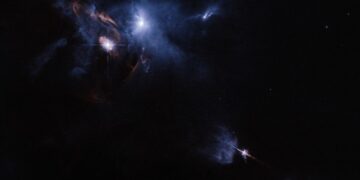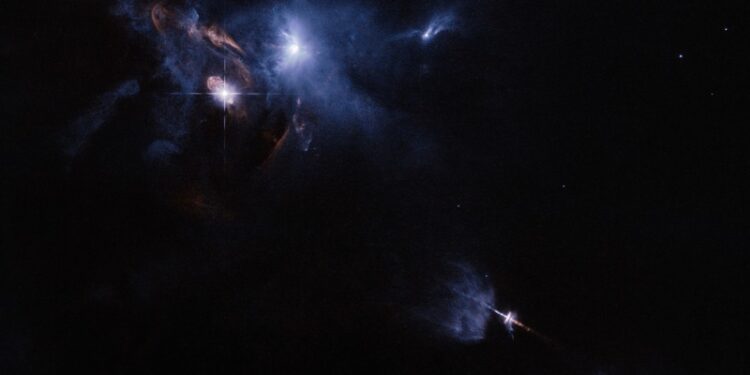Scientists have discovered a massive cloud of water vapor around the young star HL Tauri, about 450 light-years away. The vapor, which is three times the volume of Earth’s oceans, may play a key role in planet formation and offers a glimpse into the potential birth of new worlds.
HL Tauri: A Star in the Making
HL Tauri is a relatively young star, estimated to be less than a million years old, compared to the Sun’s age of about 4.6 billion years. What makes HL Tauri particularly fascinating is that it is surrounded by a dense disk of gas and dust where planets are believed to be forming.
This disk, observed with unprecedented detail thanks to ALMA’s high-resolution capabilities, gives astronomers a rare window into the early stages of planetary formation.
The water vapor detected in this disk is especially significant because it mirrors conditions similar to the ones present during Earth’s formation. Planetary formation in these protoplanetary disks follows a complex process where gas and dust clump together to form planetesimals—building blocks of planets.
Over time, these planetesimals grow through accretion, eventually forming fully-fledged planets. The presence of water vapor in such large quantities suggests that these newly forming planets are being infused with the essential ingredients for life, long before they are even fully formed.
The Role of Water in Planetary Formation
On Earth, water is involved in nearly every biological process, from the regulation of ecosystems to the sustenance of individual organisms. In the context of planetary formation, water is just as critical. The discovery of water vapor in HL Tauri’s protoplanetary disk means that water is being distributed throughout the system at an early stage, potentially laying the foundation for life-supporting environments to emerge.
The large amount of water vapor around HL Tauri suggests conditions that could lead to the formation of Earth-like planets. As these planets form, they gather gas and dust, potentially incorporating water that could later exist as liquid—essential for life. This raises the possibility that HL Tauri’s system might one day support habitable planets.
Water vapor also helps in forming organic molecules, the building blocks of life. In space, it can drive chemical reactions that produce compounds like amino acids, which are key to life’s development. This discovery not only gives insights into how planets form but also suggests life could emerge under similar conditions elsewhere in the galaxy.
A Closer Look: ALMA’s Contribution to Space Exploration
The Atacama Large Millimeter/submillimeter Array (ALMA), one of the most advanced radio observatories in the world, played a pivotal role in this discovery. Located in the high desert of Chile, ALMA uses an array of 66 high-precision antennas to capture radio waves emitted by distant celestial objects.
In this case, ALMA’s ability to detect millimeter and submillimeter wavelengths enabled scientists to observe the water vapor around HL Tauri’s disk with remarkable clarity. Prior to the development of instruments like ALMA, detecting water vapor in such distant systems would have been impossible.
ALMA’s high-resolution images of HL Tauri have revealed gaps and rings in its protoplanetary disk, indicating that planets are forming and clearing their paths. The discovery of water vapor further confirms active planetary formation, providing key insights into how systems like ours come to be.
What This Discovery Tells Us About Habitability
The discovery of water vapor around HL Tauri is a major step forward in the ongoing search for life beyond Earth. While the presence of water alone does not guarantee that life exists, it is an essential component of the environments that support life.
The conditions observed in HL Tauri’s protoplanetary disk may be similar to those that existed during the early formation of Earth, raising the possibility that habitable planets could be forming in this distant system.
One of the most exciting aspects of this discovery is that it opens up new avenues for exploring exoplanets—planets that orbit stars outside our solar system. The detection of water vapor around HL Tauri suggests that other young stars with protoplanetary disks might also contain large quantities of water.
The habitable zone of a star system is the region where conditions are just right for liquid water to exist. In our solar system, Earth lies within the Sun’s habitable zone, which is why liquid water can exist on its surface.
The Future of Space Exploration
The discovery of water vapor in HL Tauri’s disk underscores the importance of continued investment in space exploration technologies. Instruments like ALMA have revolutionized our understanding of the universe by providing unprecedented detail in the study of distant celestial objects. As scientists continue to push the boundaries of what we can observe, new insights into the formation of stars, planets, and potentially life-bearing worlds will continue to emerge.
In the coming years, the launch of the James Webb Space Telescope (JWST) and the construction of the Extremely Large Telescope (ELT) will further enhance our ability to study planetary systems like HL Tauri. These next-generation observatories will allow scientists to probe deeper into the atmospheres of distant planets, searching for biosignatures—chemical compounds that indicate the presence of life. The detection of water vapor around HL Tauri is just the beginning of what promises to be a new era of discovery in the search for habitable worlds.
Conclusion
The detection of water vapor around HL Tauri is a groundbreaking discovery that has far-reaching implications for our understanding of planetary formation and the potential for life in the universe. By revealing the presence of water in the early stages of planet formation, this discovery provides key insights into the conditions that may give rise to habitable worlds. With the continued advancement of telescopic technologies and space exploration efforts, scientists are now better equipped than ever to explore the vast expanse of the universe in search of life beyond Earth.
This discovery is not just a glimpse into the formation of a distant planetary system—it is a reminder of the incredible potential for discovery that lies ahead. As we look to the future, the search for water and other life-sustaining elements in the universe will remain a top priority for astronomers, bringing us ever closer to answering the ultimate question: Is there life beyond Earth?.
Reference:
Facchini, S., Testi, L., Humphreys, E., Vander Donckt, M., Isella, A., Wrzosek, R., … & Vlemmings, W. (2024). Resolved ALMA observations of water in the inner astronomical units of the HL Tau disk.



















